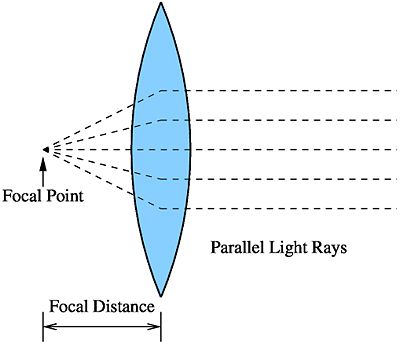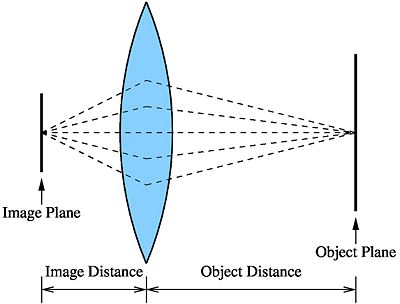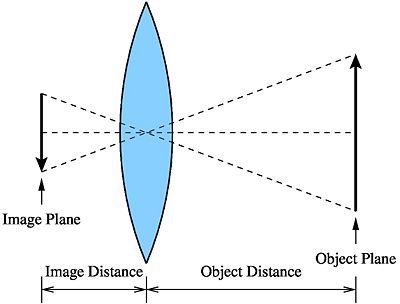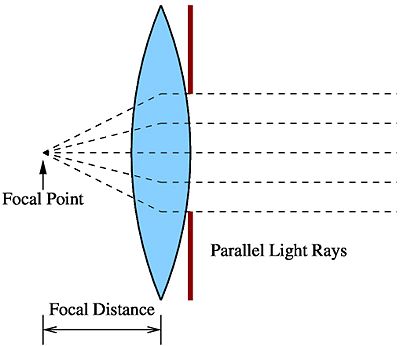Contents
Lenses in Optical Imaging Systems
keyword: ECE 637, digital image processing
Some Basic Properties and Assumptions
First let's review some basics about lenses. For these notes, we will discuss lenses assuming the thin lens model (i.e. assume that the thickness of the lens is negligible compared to its focal length).
When parallel light rays are incident upon a biconvex lens, they converge at one point after passing through. This point is called the focal point of the lens. The distance from the optical center of the lens to the focal point is called the focal distance.
Note that the focal distance can be different for the two sides of the lens if the lens is not perfectly symmetric.
We can approximate light rays from a star that is many light years away to be parallel but ideally, for a point source to produce perfectly parallel light rays, it would have to be an infinite distance away from your lens.
Image Formation
Most of your photography subjects however, will not be an infinite distance away. In that case your object's distance from the lens is some finite quantity and the image plane has to be adjusted so that the image is in focus.
Let $ d_f $ be the focal length of the lens. This quantity is an intrinsic property of the lens.
Let $ d_o $ be the distance of the object plane from the optical center of the lens.
Let $ d_i $ be the distance of the image plane from the optical center of the lens.
So for your image to be in focus, the following equation must be satisfied.
$ \frac{1}{d_o} + \frac{1}{d_i} = \frac{1}{d_f} $
Notice that
$ \begin{align} d_o &= \infty \\ \Rightarrow \frac{1}{d_i} &= \frac{1}{d_f} \\ \Rightarrow d_i &= d_f \end{align} $
which is what we stated earlier when defining focal length.
Also note that
$ d_i = (\frac{1}{d_f} - \frac{1}{d_o})^{-1} $
So the smaller the $ d_o $, the smaller the reciprocal of $ d_i $ and hence the larger $ d_i $ is. In other words, as the object plane moves in, the image plane moves out and vice versa.
Magnification
Typically, when you view an image through a lens, there is an effective magnification.
Let $ M $ be the magnification factor of the lens.
For a biconvex lens,
$ M = -\frac{d_i}{d_o} $
The negative sign denotes that for a biconvex lens, the image is also inverted. This phenomena is also illustrated in the above figure.
Normally, the image you form using your camera is much smaller than the actual object. In other words, $ |M| < 1 $. So in a typical camera, we have that
$ d_o >> d_f \ $
$ \Rightarrow d_i = \frac{d_o d_f}{d_o - d_f} \approx d_f $
Additionally, if $ d_i > d_f $, then $ |M| << 1 $.
However, when the object is closer to the lens than its focal length, $ |M| > 1 $ and the image is larger than the object. This is the principle used in microscopes to magnify (in absolute terms) objects.
$ d_i >> d_f \ $
$ \Rightarrow d_o = \frac{d_i d_f}{d_i - d_f} \approx d_f $
Additionally, if $ d_o > d_f $, then $ |M| >> 1 $.
Aperture and f-Stop
The effective size of the lens is controlled by the aperture of your camera. The aperture is like the pupil of your eye. The iris contracts and dilates the pupil when you are in a bright or dark environment. Similarly you may want to limit the amount of light entering the camera to stay within the dynamic range of the sensors.
Let $ A $ be the diameter of the aperture.
Let $ d_f $ be the focal distance of the lens.
Let $ N $ be the f-stop of the lens.
Then,
$ N := \frac{d_f}{A} $
Also the area of the aperture is given by
If N is large, then A is small, meaning that less light enters the lens. You may have to leave your aperture open for longer to get a bright picture but this also increases the chances of blurriness unless your subject is very still throughout the exposure. The lens is often described to be slow.
If, on the other hand, N is small, A is large. You have lots of light coming in at once so you need a faster shutter speed (a faster lens). This design is generally more expensive and is handy when you are doing sport photography.
Since light is proportional to the area of the aperture,
$ Light \propto Area = \frac{\pi A^{2}}{4} = \frac{\pi}{4}(\frac{d_f}{N})^{2} = \frac{\pi d_f}{4}\frac{1}{N^{2}} $
So we wee that light is inversely proportional to the square of $ N $. Theoretically, the larger the aperture, the sharper the image. However, this is not always true in practice.





